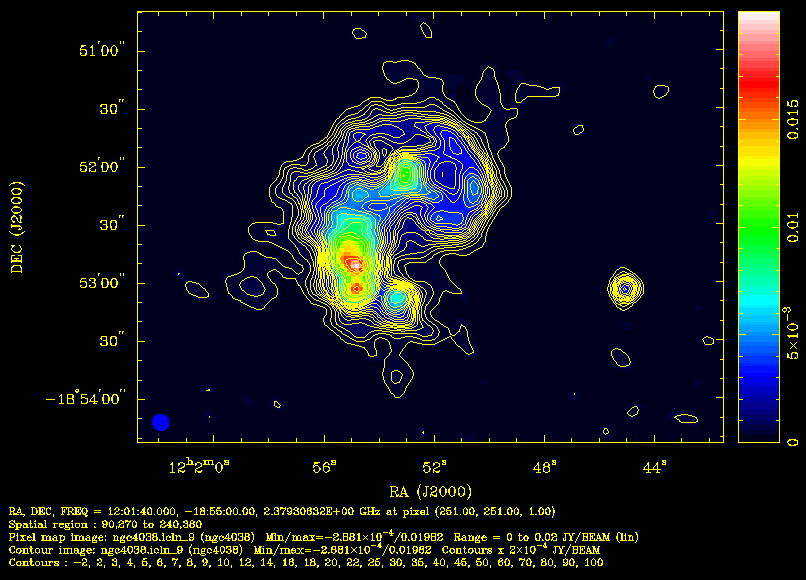"The MM-Wave Upgrade"
The Australia Telescope Compact Array
(ATCA) is a radio interferometer
consisting of six 22-m antennae aligned along a 6-km-long, east-west track.
It is currently operating in four frequency bands around 1.4 GHz (20 cm),
2.3 GHz (13 cm), 4.8 GHz (6 cm), and 8.6 GHz (3 cm), achieving a maximum
angular resolution of one second of arc (1"), which is similar to
the resolution reached by ground-based optical telescopes.

Fig. 1: Five antennas of the ATCA.
(copyright CSIRO, photo J. Masterson)
The ATCA Upgrade, which is part of the Major National Research Facility
(MNRF) program, will
allow astronomers to observe at even higher frequencies, around 22 GHz (12 mm)
and 90 GHz (3.5 mm). The ATCA will thus be the first millimetre
interferometer in the Southern Hemisphere! And, at the above frequencies,
it will be at least as good as existing millimetre interferometers in the
Northern Hemisphere.
The ATCA Upgrade will open a number of new opportunities;
these are set out below.
- The spectrum at millimetre wavelengths is incredibly
rich in spectral lines, most of them coming from rotational
transitions of various molecules and their isotopes (e.g., C_3H_2,
SiO, 13CS, HCN, HCO+, CH_3CN, CS, SO, 13CO, CN, CO), and allows us,
for example, to analyse the chemical composition of molecular clouds
in our Galaxy.
- Objects such as the Galactic Centre, the southern Galactic Plane,
our nearest neighbours the Magellanic Clouds including supernova
SN1987A, and many southern stars, galaxies and quasars will be
observed for the first time at high frequencies and high angular
resolution (> 0.3").
- Water-vapour masers at 22 GHz have recently been used to infer a black
hole in the centre of the galaxy NGC 4258. We will use the ATCA
to measure the kinematics of masers in many southern galaxies which are
similar to NGC 4258 (e.g., Circinus, NGC 4945) and search for masers
in other galaxies.
- A large amount of cold molecular gas is a good indicator of star
formation in galaxies as stars are made out of this gas. In the nuclei
of strongly interacting or merging galaxies the star formation
rates are particularly high (see Fig. 2) and, consequently, we find a
high concentration of dense molecular gas there.
- Whereas most telescopes work at either centimetre- or millimetre-wave-
lengths (because of the different requirements and observing techniques)
we will have a huge telescope which can do both.

Fig. 2: The nuclei of two colliding galaxies, NGC 4038/9 also called
``The Antennae'', observed at a wavelength of 13 cm.
The ATCA Upgrade involves the following projects:
- design and construction of six cryogenically cooled 3.5-mm receivers
covering the frequency range of at least 85-95 GHz; this
includes one spare. Only the five antennae on the 3-km arm of the
ATCA will be outfitted with these receivers;
- design and construction of seven cryogenically cooled 12-mm receivers covering
the frequency range of about 18-25 GHz; this
includes one spare. The receivers will be co-located with the 3.5-mm
receivers in the same cryogenic dewar in the receiver turret. Options
for a 7-mm future upgrade will be considered in the design of the dewar;
- extending the solid surface of five ATCA antennae
from 15- to 22-m diameter. Holography will be used to adjust the full
surface of each antenna to an accuracy of 0.15 mm;
- study of atmospheric phase correction strategies, e.g. by using
water-vapour radiometers operating at either 225 GHz or 22 GHz;
- local oscillator upgrade to achieve the desired phase stability
for operation at millimetre wavelengths using optical fibres;
- add several extra antenna stations on the existing east-west track;
- construction of a short north-south spur with several new antenna
stations.
Fig. 3: Six telescopes make 15 two-element interferometers. Shown are
the tracks of each interferometer observing a source at a declination
of -50 degrees. Displayed on the left is the uv-coverage of a
12-h observation with the telescopes aligned on the current east-west
track (Figure 1). The more dense and uniform the coverage the easier
it is to reconstruct an image of the source from the observations.
Seen on the right side is a combination of two 6-h observations, one
with a standard east-west array and the other with a new configuration
including the north-south spur. This observing mode will be used
mainly at high frequencies to avoid taking data at low elevation
where the atmospheric attenuation is large. --- Using a Java applet
you can create your own Virtual Radio Interferometer (V.R.I.) at
http://wwwnar.atnf.csiro.au/astronomy/vri.html.
All projects are well under way and completion is expected in January 2002.
Until then we will use the 22-m Mopra antenna near Coonabarabran and, for example, the
15-m Swedish-ESO Submillimetre Telescope (SEST) in Chile at high frequencies, but
relatively low resolution (about 40"), to prepare for the future millimetre
observations of the upgraded ATCA.

Fig. 4: The 22-m Mopra antenna.
(copyright CSIRO, photo J. Masterson)
More up-to-date information on the individual projects, especially the 3.5-mm
system upgrade, and related topics, can be found on the World-Wide-We
at http://www.atnf.csiro.au/overview/mnrf/projects/3.5mm/3.5mm_project.html.



